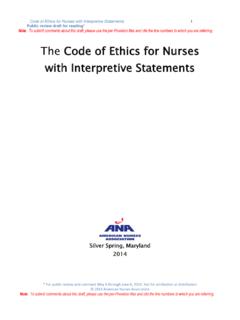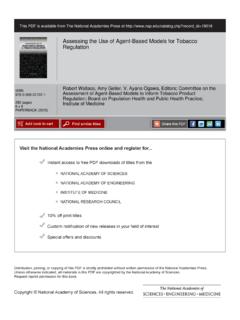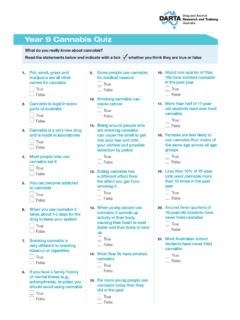Transcription of Interpretation of Clinical Laboratory Tests
1 1 Interpretation of Clinical Laboratory TestsMichael P. Peppers, Manager, St. Louis BranchLearning Objectives Discuss the importance of When to draw labs What a Normal Lab Value means What an Abnormal Lab Value means Potential for error in Laboratory test values Units of measure Timing Technique in drawing Discuss the differences in chemistry fil List 3 class of drugs that require periodic drug level monitoring To minimize adverse reactions To maximize effectiveness. List one frequently monitored test value for Asthma Congestive heart failure DiabetesdateInterpretation of Clinical Laboratory Testsprofiles BMP (SMA-6, Basic Metabolic Profile) Chem Panel-12 (SMA-12) CMP (Complete Metabolic Profile, Chem Profile-20) Renal Panel Critical Care Panel Cost/benefit issues. is a Blood test? An essential diagnostic tool that reveals details about: Blood cells Blood components Fluids and Electrolytes ElectrolytesN tritional stat sdateInterpretation of Clinical Laboratory Tests Nutritional status Body organ function Acid-base status Immune function Compliance with medication regimens2 Blood Components Plasma (semi-solid component) Plasma Albumin, immunoglobulin, coagulation factors, protein C and S, fibrinogen, antithrombin, platelets, etc.
2 Turns into a solid when clotting cascade activateddateInterpretation of Clinical Laboratory Tests Serum (liquid component) Disolved components, drugs, electrolytes, gases, etc. Serum, The remaining liquid, which can be used in blood Tests to assist in determing how various body organs may be functioning When should we actually draw a blood test? Suspicion leads the clinician to believe there is a medical problem Infectious diseases (CBC/Differential; Legionella titers, Tularemia, etc.) VTE / Pulmonary embolism (D-Dimer) Adrenal Insufficiency (Serum Cortisol pre and post Cosyntropin Injection) Hypo / Hyperthyroidism (Cardiac Arrhythmias, Fatigue, FUO, etc.) Systemic Lupus Erythematosus Inflammatory Conditions (CRP, ESR) And ON. BASICALLY To ASSISTin confirmation of diagnosisdateInterpretation of Clinical Laboratory Tests To follow up on prescribed therapy Serum Drug Levels (gentamicin, vancomycin, digoxin, theophylline, thiocyanate) Hemoglobin A1-C (HgA1C) Prostate Specific Antigen (PSA) Culture and Sensitivities (C&S) Carcinoembrionic Antigen (CEA)
3 Should NOT draw lab test if nothing is going to be acted uponCommon conditions for acquiring blood lab Tests Allergies Autoimmune Diseases Blood Cholesterol Diabetes Nutritional status Gastrointestinal Diseases Heart Health Hormones and MetabolismdateInterpretation of Clinical Laboratory Tests DNA, Paternity and Genetic Testing Drug Screening Environmental Toxin Infectious Disease Kidney Disease Liver Diseases Sexually Transmitted Diseases Thyroid Disease 3 Specialized lab Tests Specific disease states Specific drug therapy Implications for case managementOverviewdateInterpretation of Clinical Laboratory Tests Serum, blood, urine, CSF other fluids Screening Qualitative Urine drug screens Example (urine drug screen obtunded teenage girl opiates) Diagnostic Quantitative Serum drug levels Example (serum Fentanyl Level 5 mcg/ml in same teenage girl, 2 days post presentation to ICU with no narcotics given in past 2 days DATE RAPED with fentanyl disk)General PrinciplesdateInterpretation of Clinical Laboratory Tests Cost vs benefit Benefit must outweigh the cost or danger of procedure Every blood stick introduces chance for infection Daily blood sticks or multiple blood draws throughout therapy may lead to anemia such as seen in the ICU or in the chronic dialysis patient (multiple blood draws do contribute to some of the anemia in dialysis patients due to their lack of erythropoetin in regenerating substrate)
4 Outcome must affect decisions in therapeutic management BNP greater than 400 in acutely decompensated CHF patient NATRECOR treatment (expensive drug, but will keep patient out of ICU)General Principles: Normal Values Normal Range Defined by healthy population Vary widely within age groups, weight groups, sex, feeding status THUS, normal is only normal in the bell curve of a population is NOT NORMAL serum drug therapeutic, subtherapeutic and toxic ranges. Pediatric values are different than adult values Variations among labs Use norms listed by lab, keep in mind that there are three blood test "normal ranges." Personal Norms Just like temperature, all have individual normals High normal may be extreme high in some patients (example: WBC 10,000 dateInterpretation of Clinical Laboratory Tests Variations do exist Age, Sex, wt, ht, food, drug-effect, diseases, etc.)
5 Serum creatinine is a fantastic example of how one can MISINTERPRET renal function in the eldery Renal Dysfunction, pregnancy and neonate are fantastic examples of how one can MISINTERPRET serum digoxin levels Personal Normsp(p,may be normal in most, but someone who normally runs 4,000, this could be signs of serious infection) Be sure to review the individual labs reference points for normal ranges when assessing4 Lab Error Specimen problem hemolyzed blood Hyperkalemia, hyperphosphatemia. Lipemic Serum Pseudo-hyponatremia CPK enzymes in patient lying on floor too long Wrong time Vancomycin / Gentamicin Peak / Trough Frequently misinterpreted as too low Medications Pseudoephedrine or Conserta showing up as illicit amphetamines Incomplete Not enough serum for the procedure Technical errors, procedures, reagents Decimal place errors when reportingdateInterpretation of Clinical Laboratory Testsqypor too high due to improper timing Acetaminophen Toxicity False Interpretation if drawn too soon or too late Digoxin Level 12 hours to distribute into tissues / false high if drawn too soon Not waiting long enough post fatty meal to perform BS, Triglycerides.
6 Cholesterol levelsDecimal place errors when reporting Wrong patient name on vial Drawing Nutrition support labs or serum drug levels out of the same port into which the drug/TPN is being administered Diet Conventional units SI units Example:Conventional glucose SI unit glucose70-110 mg/dL39-6 1 mmol/LUnits of MeasuredateInterpretation of Clinical Laboratory Tests70-110 mg/dL mmol/LBe sure to note which units are being referred to when reading journal articles about diseases and therapy. USA and other countries do not always follow same reporting structure. BMP (Basic Metabolic Panel, SMA-6) analyzes Na, K, Cl, CO2, BUN, glucose insights into serum electrolytes, acid-base status, renal function and metabolic state Chem Panel-12 (SMA-12) add: albumin, total protein, bilirubin, alk phos, calcium and creatinine more specific renal evaluation, and liver function, nutritional parameters Missing for Nutritional needs is Mg, PO4, Pre-Albumin, TriglyceridesBlood ChemistrydateInterpretation of Clinical Laboratory TestsMissing for Nutritional needs is Mg, PO4, PreAlbumin, Triglycerides Chem Profile-20 (CMP) Add.
7 Phosphorus, cholesterol, triglycerides, uric acid, iron, lactate dehydrogenase (LD), aspartate aminotransferase (AST), and alanine aminotransferase (ALT) Additional metabolic information, cardiovascular risk, and liver function Missing is MAGNESIUM5 Magnesium and Phosphate Very important electrolytes that are frequently missing in basic panels Both cause problems in managing other electrolytes if not assessed appropriately Magnesium Catalyst for the Na-K-ATP PumpBlood Chemistry (cont.)dateInterpretation of Clinical Laboratory Tests Phosphate Vital component in all enzyme actions and the ATP Pump Critical Care Panel ABG (arterial blood gas: pCO2, pO2, pH, HCO3) Ionized Calcium Magnesium BMP (Na, K, Cl, CO2, BS, BUN, Creatinine) Very important to interpret all the above in concertIdH Aid i thi h thKBlood Gases and Acid-BasedateInterpretation of Clinical Laboratory Tests Increased pH Acidemia expect higher than norm K Decreased pH Alkalemia expect lower than norm K pH, pCO2, pO2 Ventilator management, toxicology management, critical care management, COPD management, DKA management, and Coagulation RBC, hematocrit (Hct), hemoglobin (Hgb), MCH, MCV, MCHC Anemias Macrocytic Microcytic Do we use IRON or do we use FOLIC ACID / B-12 or do we use Erythropoetin or do we combine ll thb?
8 Platelets Thrombocytopenia idiopathic? Thrombocytopenia drug induced? ESR Inflamation vs not? Allergic reaction? PT, aPTT, fibrinogenTherapeutic drug ?dateInterpretation of Clinical Laboratory Testsall the above? Acute onset vs chronic onset? Do we transfuse or not? WBC/differential Bacterial vs Viral Drug-Induced adverse effect Therapeutic drug ? Liver function ? Disseminated intravascular coagulation? How to stop the bleed ? 6 Infectious Disease: aminoglycosides (amikacin, gentamicin, tobramycin), vancomycin Pulmonology:aminophylline, theophylline Cardiology:lidocaine, procainamide, propranolol, quinidine, digoxin, digitoxin, BNP, thiocyanateTherapeutic Drug MonitoringdateInterpretation of Clinical Laboratory Tests Neurology:carbamazepine, phenobarbital, phenytoin, antiepileptics in gerneral Psychiatry: valproic acid Clinical importance Maintain safest parameter for best therapeutic outcome Influenced by many factors Compliance, Interaction, Demographics, Clinical conditionDrug LevelsdateInterpretation of Clinical Laboratory Tests Clinical condition, Timing of administration/collection) NO NORMAL levels in human body, thus each person may be affected slightly different than another Digoxin is prime example 2 % of population will be toxic within therapeutic rangeDrug Levels (cont.
9 Peak level highest concentration detected between doses, within the post distribution phase Trough level Lowest level detected prior to next dose Sub-Therapeutic Range Toxic Range Levels above which the toxic effects manifest quite often Toxic effects from commonly monitored drugs Antibiotics Bronchodilators Anticonvulsants dateInterpretation of Clinical Laboratory Testspg Level below which no therapeutic effects will be seen Therapeutic Range lowest level of effectiveness extending to the highest level of effectiveness without toxicity Cardiac glycosides Evaluate in conjunction with Renal function, Hepatic Function, Cardiac Function, Hydration status, Patient signs/symptoms7 Indicate effectiveness of therapeutic regimen Current status and underlying disease state evaluation Disease States Frequently Monitored ValuesdateInterpretation of Clinical Laboratory Tests Commonly used indicators for: diabetes CHF asthma cancer nutrition Blood glucose Acid/base Glycosylated hemoglobin (HgbA1C)DiabetesdateInterpretation of Clinical Laboratory Tests DKA.
10 Blood glucose >250mg/dL (> ) and venous pH < or serum bicarb level <15 MEq/l ketonuria and/or ketonemia Uncontrolled diabetes Hyperglycemia with volume depletionDiabetes Criteria for AdmissiondateInterpretation of Clinical Laboratory Tests recurring blood glucose >300 mg/dL recurring episodes of hypoglycemia, or unstable hyper- and hypoglycemic episodes8 Blood glucose trends information (daily basis) for adjustments in therapy regimen Glycosylated hemoglobin (HgbA1C) predicts risk for development of chronic complications measured every 3 monthsDiabetes Ongoing AssessmentdateInterpretation of Clinical Laboratory Tests goal: <7%, reevaluate treatment regimen if >8% Peak flow PEF based on personal best established over 2-3 weeks of measurement PEF < 80% indicates need for additional meds PEF <50% indicates a severe asthma exacerbation Drugs: routine monitoring of serum theophylline is important in long-term tlAsthmadateInterpretation of Clinical Laboratory Testscontrol zileuton (leukotriene modifier), monitor hepatic enzymes (ALT) IgE level: Allergic asthma Rx: Omalizumab Drug levels ( digoxin) Critical following the addition of amiodarone Critical following decrease in renal function Critical as patient ages and renal function declines BNP: also known as: b-type natriuretic peptide, proBNP Greater than 400 may suggest possible decompensated CHF and need for niseritide (Natrecor) Fluid/electrolyte BUN creatinine BUN.


















